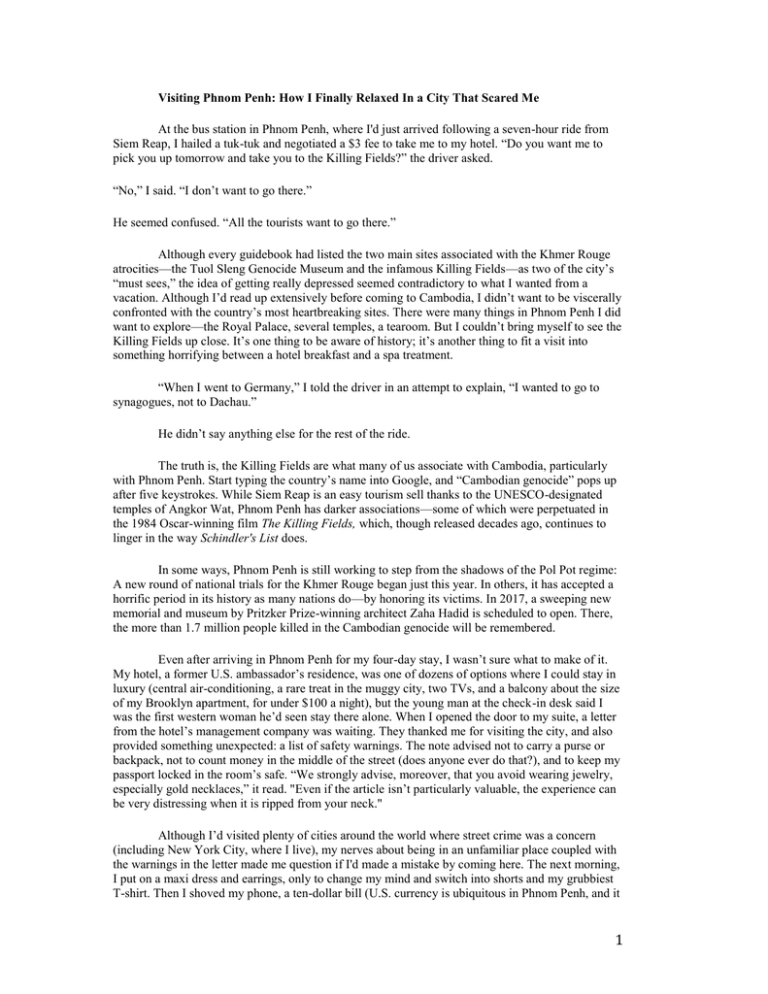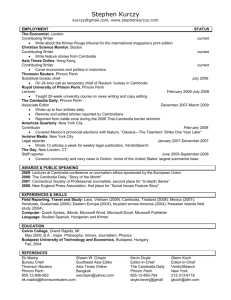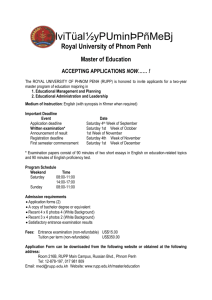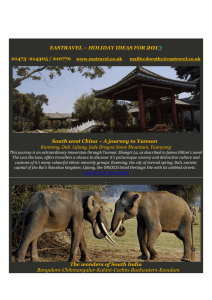Visiting Phnom Penh: How I Finally Relaxed In a City... At the bus station in Phnom Penh, where I'd just... Siem Reap, I hailed a tuk-tuk and negotiated a $3...
advertisement

Visiting Phnom Penh: How I Finally Relaxed In a City That Scared Me At the bus station in Phnom Penh, where I'd just arrived following a seven-hour ride from Siem Reap, I hailed a tuk-tuk and negotiated a $3 fee to take me to my hotel. “Do you want me to pick you up tomorrow and take you to the Killing Fields?” the driver asked. “No,” I said. “I don’t want to go there.” He seemed confused. “All the tourists want to go there.” Although every guidebook had listed the two main sites associated with the Khmer Rouge atrocities—the Tuol Sleng Genocide Museum and the infamous Killing Fields—as two of the city’s “must sees,” the idea of getting really depressed seemed contradictory to what I wanted from a vacation. Although I’d read up extensively before coming to Cambodia, I didn’t want to be viscerally confronted with the country’s most heartbreaking sites. There were many things in Phnom Penh I did want to explore—the Royal Palace, several temples, a tearoom. But I couldn’t bring myself to see the Killing Fields up close. It’s one thing to be aware of history; it’s another thing to fit a visit into something horrifying between a hotel breakfast and a spa treatment. “When I went to Germany,” I told the driver in an attempt to explain, “I wanted to go to synagogues, not to Dachau.” He didn’t say anything else for the rest of the ride. The truth is, the Killing Fields are what many of us associate with Cambodia, particularly with Phnom Penh. Start typing the country’s name into Google, and “Cambodian genocide” pops up after five keystrokes. While Siem Reap is an easy tourism sell thanks to the UNESCO-designated temples of Angkor Wat, Phnom Penh has darker associations—some of which were perpetuated in the 1984 Oscar-winning film The Killing Fields, which, though released decades ago, continues to linger in the way Schindler's List does. In some ways, Phnom Penh is still working to step from the shadows of the Pol Pot regime: A new round of national trials for the Khmer Rouge began just this year. In others, it has accepted a horrific period in its history as many nations do—by honoring its victims. In 2017, a sweeping new memorial and museum by Pritzker Prize-winning architect Zaha Hadid is scheduled to open. There, the more than 1.7 million people killed in the Cambodian genocide will be remembered. Even after arriving in Phnom Penh for my four-day stay, I wasn’t sure what to make of it. My hotel, a former U.S. ambassador’s residence, was one of dozens of options where I could stay in luxury (central air-conditioning, a rare treat in the muggy city, two TVs, and a balcony about the size of my Brooklyn apartment, for under $100 a night), but the young man at the check-in desk said I was the first western woman he’d seen stay there alone. When I opened the door to my suite, a letter from the hotel’s management company was waiting. They thanked me for visiting the city, and also provided something unexpected: a list of safety warnings. The note advised not to carry a purse or backpack, not to count money in the middle of the street (does anyone ever do that?), and to keep my passport locked in the room’s safe. “We strongly advise, moreover, that you avoid wearing jewelry, especially gold necklaces,” it read. "Even if the article isn’t particularly valuable, the experience can be very distressing when it is ripped from your neck." Although I’d visited plenty of cities around the world where street crime was a concern (including New York City, where I live), my nerves about being in an unfamiliar place coupled with the warnings in the letter made me question if I'd made a mistake by coming here. The next morning, I put on a maxi dress and earrings, only to change my mind and switch into shorts and my grubbiest T-shirt. Then I shoved my phone, a ten-dollar bill (U.S. currency is ubiquitous in Phnom Penh, and it 1 was convenient not to have to change money on arrival), a tube of lip balm, and a card with the name and address of the hotel into my pockets, then set off to explore. The city whizzed at an unrelenting pace. There were no crosswalks, no streetlights, no sidewalks, no stop signs, no seat belts. And yet, it seemed to work—people on motorbikes or driving cyclos made eye contact and hand gestures to signal if they were turning or passing, somehow not colliding. Even at the tourist-packed Royal Palace, it was surprisingly easy to take dozens of pictures of the bright yellow and red turreted buildings and the famous silver pagoda without ever having to wait for anyone to move out of the way. There were other peaceful pockets of the city. Some of Cambodia’s finest artifacts were in an unguarded museum with little more than two ceiling fans for company. At the National Library, a modest pale-yellow building that had many of its books destroyed during the Khmer Rouge era, the simple act of Cambodians sitting in a room and reading for pleasure felt beautiful and extraordinary when I thought back to how intellectuals were killed or sentenced to hard labor decades before. Slowly, I could feel myself easing up. When I stopped into a cafe to recharge with a cold drink, I resisted the urge to pull out my phone. Instead, I thumbed through the local English-language newspaper and watched the world outside. I’d always found so much comfort in objects to anchor me, but slowly the panic about not having a Kindle at all times melted away. I keenly felt every second tick away, without rapidly updating my Twitter feed to distract me. As if in response to my living-in-the-moment attitude, Cambodia revealed itself in little pieces. At a restaurant called Romdeng, I stared in impressed horror as a man a few tables down ordered the house specialty, deep-fried tarantula. ("They're free range," the server said without a hint of humor.) I opted for fish amok, a traditional mild curry dish served inside a banana leaf, and a Beerlao, a Laotian beer brewed with rice. At Estampe, an art gallery packed with maps, prints, and artifacts from the Indochina era, I bought a painting of an elegant cruise liner against a bright yellow background, based on a French advertisement. Walking back to the hotel with the painting tucked under my arm, I made eye contact with a teenage girl crossing the street, and she smiled at me. I smiled back. Two boys waved from their motorbike. I’d spent so much of the trip (and the time leading up to it) steeling myself for dangers I was sure existed, nervous about what or who I might encounter. But every city is a collection of the people who live in it, and the Cambodians I had chances to interact with were uniformly kind, open, and proud of their transforming country. On my last night in Phnom Penh, there was one thing left on my "must do" list: a drink at Raffles Hotel Le Royal 's Elephant Bar. I loved the bar’s safari lodge-inspired look and the Femme Fatale cocktail, which was made in honor of Jackie Kennedy's visit to the country in 1967. (It has champagne and crème fraîche, to match her pink lipstick.) Plenty of other tourists had had the same idea. At the bar, I met Mike, an Australian tourist who had 36 hours in town as part of a package tour that would take him to Vietnam the following day. He had only enjoyed a sliver of Phnom Penh, and when he learned I’d had several full days, he rattled off questions: Had I tried any local dishes worth recommending? Could you walk from the Royal Palace to the National Museum, or were they too far apart? I told him about about the half a dozen neighborhood bakeries with bread and pastries rivaling anything I’d eaten in France, for a fraction of the price; how for $10 U.S., he could spend an entire day in the swimming pool of an upscale hotel, using their Wi-Fi and ordering drinks from a swim-up bar; how the street numbers skipped from 100 to 240 with no explanation. Over the course of my short trip, many of my initial suspicions had melted away without me ever noticing. Riding back to the hotel, I didn’t think about the fact that I was a single woman out alone in a strange city. And for the first time since arriving, I didn’t clutch the sides of the tuk-tuk in terror while balling a fist around the cash in my pocket, and instead took a final look at the buildings I’d gotten to know—including the French Colonial-style post office, and the "tea hotel" with a lush garden in its open-air lobby. Travel always feels like a gift, but this trip to Phnom Penh more so, as if I’d been told a wonderful secret. As my trip came to an end, the tuk-tuk seemed to fly down the busy, 2 electric streets of the city, and I was glad I had opened my eyes to more than its dark past, regretting that I wasn't staying longer. Written by Lilit Marcus March 07, 2016 3




